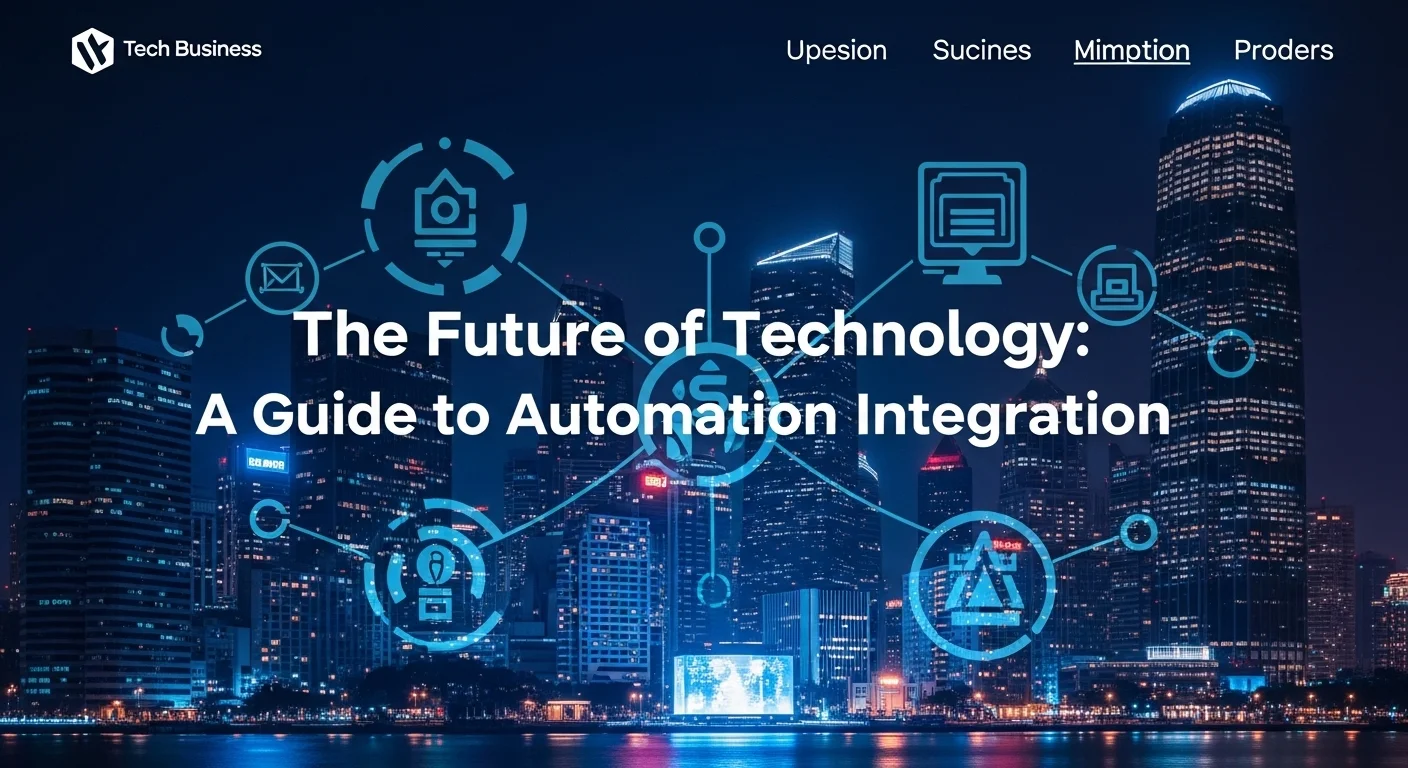What is Automation Integration? A Real-World Guide for Business and Home

Executive Summary
For years, I've seen businesses and homeowners struggle with the same problem: a collection of fantastic tools that just don't talk to each other. Automation integration is the magic that fixes this. It’s like teaching your software to cooperate, creating smooth, automated processes that save you time and headaches. Whether you're trying to streamline a company's sales process or create the ultimate smart home, this article is your starting point. We'll break down the core ideas, look at real-world examples, and show you why understanding this concept is no longer a luxury—it's essential for staying ahead.
Table of Contents
Table of Contents
- What is Automation Integration and Why Does It Matter?
- Real-World Business Applications and Benefits
- A Look at Home and Security Integration
- The Tech Behind the Magic: APIs, Webhooks, and More
- Building Your Integration Strategy
- The Quest for the Perfect Smart Home
- Practical Tips for Guaranteed Success
- Best Tools for the Job
- Enhancing Your Home Tech Experience
What is Automation Integration and Why Does It Matter?
In my line of work, I see a lot of complex tech, but few ideas are as powerful and transformative as automation integration. Put simply, it’s the process of getting your different software, apps, and systems to talk to each other and work together automatically. Imagine a digital orchestra where every app is an instrument, all playing in perfect harmony without a human conductor. That's integration. It breaks down the walls between your data, gets rid of mind-numbing repetitive tasks, and creates a single, smart system where information flows exactly where it needs to. Why is this so crucial? Because today, every business runs on a dozen different tools—a CRM, accounting software, marketing platforms, you name it. Without integration, you're just juggling a bunch of separate, inefficient tools. With it, you unlock their true potential and make the whole operation smarter and more agile.
But this goes way beyond just being efficient. It's the engine of real innovation. When your systems are connected, they share data in real-time, giving you a complete picture of your business, your customers, and the market. This wealth of data is where the magic happens. You can feed it into AI and machine learning tools to get sharp insights, predict what’s coming next, and make decisions based on facts, not guesswork. For instance, I've helped clients connect their sales CRM with their marketing platform. The result? They could see a customer's entire journey, from the first ad they clicked to the final sale, allowing them to personalize every interaction. You simply can't do that when your systems are isolated. Plus, integration is built for growth. As your business expands, manual processes become crippling bottlenecks. A solid integration framework scales with you, handling more data, more tools, and more complex workflows without breaking a sweat.
Real-World Business Applications and Benefits
The impact of automation integration is felt everywhere in a business. In the finance department, I’ve seen it automate everything from sending invoices to tracking expenses, which cuts down on manual entry and costly mistakes. For HR, it can make the entire employee journey, from hiring to payroll to performance reviews, a smooth, automated flow. In customer service, linking a support ticket system to a knowledge base gives agents the answers they need instantly, leading to happier customers. E-commerce is a perfect example; integration is the invisible force that manages inventory, processes your online order, and coordinates shipping so your package arrives on time. On a more personal level, home automation integration is a great way to see these principles in action. It’s all about connecting your lights, thermostat, and locks into one smart system. The goal is the same as in business, just on a different scale: connect everything to make life simpler and more efficient.
The benefits are tangible and hard to ignore. The first thing you'll notice is a huge boost in efficiency. When you automate the boring stuff, your team is free to focus on creative, strategic work that actually grows the business. This isn't just about productivity; it boosts morale because nobody enjoys tedious data entry. The cost savings follow quickly. Less manual work, fewer errors, and smarter use of resources all add up to significant savings. Another huge win is data you can trust. When data syncs automatically between systems, everyone is working from the same playbook. This reliability is the foundation for accurate reports and smart planning. Ultimately, all of this makes your business more agile. In today's market, the companies that can adapt and respond quickly are the ones that win. Automation integration gives you that competitive edge.
A Look at Home and Security Integration
If you want to see automation integration in your daily life, look no further than the modern smart home. The dream for many of us is achieving fully integrated home automation. This means creating a home that practically runs itself. Imagine your lights turning on as your car pulls into the driveway, your thermostat adjusting automatically when you leave the house, and your coffee maker starting up the moment your alarm rings. This seamless coordination is made possible by integration platforms that allow devices from different brands to communicate, using standards like Wi-Fi, Zigbee, and Matter.
A huge part of this world is home automation security system integration. For many people, security is their first step into the smart home. When you connect security cameras, door sensors, and smart locks, you get powerful, layered protection. But when you integrate them with the rest of your smart home, they become even smarter. For example, if a smoke detector goes off, the system can instantly unlock the doors for a quick escape, turn on all the lights to show the way, and shut off the air conditioning to stop smoke from spreading. It’s this kind of intelligent, coordinated response that truly shows the power of integration.
People are always looking for simple, all-in-one solutions, which has made systems like SimpliSafe very popular. The conversation around SimpliSafe home automation integration is growing because users want their trusted security system to play nicely with other gadgets. While it's great on its own, it becomes even better when integrated with Amazon Alexa or Google Assistant, letting you arm your system with just your voice. It can also work with August smart locks to automatically lock up when you leave. While it might not be the most advanced example of fully integrated home automation yet, it shows the trend: everyone recognizes the value of connected systems. The hunt for the best integrated home automation systems often leads to dedicated hubs like Hubitat or Home Assistant. These are designed to be the brain of your smart home, giving you a central place to connect and control everything, creating a space that’s truly tailored to you.

The Tech Behind the Magic: APIs, Webhooks, and More
Getting into the nuts and bolts, automation integration relies on a few key technologies. You don't need to be a developer to understand the basics, and knowing them helps you make smarter choices. The most common tool in the box is the API, or Application Programming Interface. I like to think of an API as a menu at a restaurant. It lists what you can 'order' from an application (what data you can request) and how you need to ask for it. It's a standardized way for different software programs to talk to each other. Most modern web integrations, from your phone's weather app to complex business software, are powered by APIs.
Then you have Webhooks, which work a bit differently. Instead of your app constantly asking another app, 'Anything new? Anything new?' (which is how some APIs work), a webhook is like a notification. When something specific happens in one app—say, a customer makes a purchase on your website—that app automatically sends a 'ping' with the relevant info to another app, like your accounting software. It's incredibly efficient and ensures data moves in real-time. For bigger, more complex jobs, companies often use something called Middleware. Middleware is like a universal translator that sits between all your different systems, helping them understand each other. A modern, cloud-based version of this is called an iPaaS (Integration Platform as a Service). Think of services like MuleSoft or Workato as powerful hubs designed specifically to build, manage, and scale these connections, often with pre-built connectors that make the process much easier.
Building Your Integration Strategy
From a business standpoint, the tech is only half the battle. A successful project starts with a solid plan. The first thing I always tell my clients is to map out their current processes. Where are the delays? Where are the repetitive tasks? Where is data getting lost? Talk to the people doing the work—they know where the real pain points are. Once you have a list of potential automation projects, prioritize them. Start with a small, high-impact project to get a quick win. This builds confidence and shows everyone the value of what you're doing.
Developing a long-term integration strategy is crucial. This isn't about one-off fixes; it's about building a foundation for the future. You need to decide on your preferred tools and set clear rules, or governance, for how integrations are built and managed. This is a step people often skip, and it's a huge mistake. Without governance, you end up with a tangled mess of connections that no one understands—I’ve seen it happen, and it’s not pretty. Good governance means defining who owns the data, setting up security protocols, and having a plan for when things go wrong. Comparing your resource options is also key. Do you build in-house? Hire a consultant? Use an iPaaS platform? You need to weigh the costs and benefits of each, looking at factors like ease of use, security, and scalability to find the right fit for your company.
The Quest for the Perfect Smart Home
These business principles apply perfectly to the world of smart homes, especially for anyone searching for the best integrated home automation systems. Just like a business analyzes its workflows, you should look at your daily routines. What parts of your day could be smoother? The ultimate goal is fully integrated home automation, where your home seems to anticipate your needs.
The tech mirrors the business world too. APIs allow your Google Home to control your Spotify, and services like IFTTT (If This Then That) act like simple webhooks, letting one device's action trigger another. The market is full of options, and choosing the right system hub is the most important decision. Platforms like Samsung SmartThings, Hubitat Elevation, and the open-source Home Assistant are the top contenders. They act as the 'middleware' for your home, supporting different device languages (Zigbee, Z-Wave, etc.) and giving you a central dashboard to create automations. Your choice often depends on what you value most. SmartThings is user-friendly and great for beginners. Hubitat is for those who want more power and privacy, as it runs everything locally in your home. Home Assistant is the ultimate playground for tech enthusiasts who want total control and endless customization, but it requires more technical know-how.
Security is non-negotiable, making home automation security system integration a vital part of any setup. A great smart home doesn't just add security; it weaves it into every automation. This is where you might look into SimpliSafe home automation integration. While SimpliSafe is a fantastic security system on its own, its power multiplies when you connect it to a hub like Home Assistant. Suddenly, a SimpliSafe door sensor doesn't just trigger an alarm; it can also turn on your lights and adjust your thermostat. This shows a key truth: the best systems are often a mix of carefully chosen products that are integrated to create a powerful, personalized ecosystem. The goal of a fully integrated home automation setup isn't just to be 'smart'—it's to be intelligent, secure, and effortlessly in sync with your life.

Practical Tips for Guaranteed Success
Whether you're overhauling a company's entire software stack or just starting your smart home journey, a few core principles will save you a lot of headaches. I've learned these over years of experience, sometimes the hard way. The most important tip is to start with a crystal-clear goal. Before you touch any technology, ask yourself: 'What problem am I actually trying to solve?' and 'What does success look like?' For a business, a great goal might be 'Reduce the time it takes to process an invoice by 50%.' For a homeowner, it could be 'Lower my monthly energy bill by 15%.' Having a specific, measurable goal gives you a clear direction and helps you make smart decisions along the way.
My second piece of non-negotiable advice is to make security your top priority from day one. When you connect systems, you create new pathways for data to flow, and you have to protect them. This means using strong data encryption, secure authentication methods, and doing regular security checks. This is especially true for home automation security system integration, where a security failure can impact your family's physical safety. Always stick with trusted brands that have a good reputation for security and are transparent about their privacy policies. A good rule of thumb is the 'principle of least privilege'—only give an application access to the absolute minimum data it needs to do its job. This limits the damage if any single part of your system is ever compromised.
Best Practices and Essential Business Tools
When it comes to the actual work, the best practice is to take small, iterative steps. Don't try to launch a massive, company-wide integration all at once. I call that a 'big bang' approach, and it often ends in a big mess. Instead, start with a small pilot project. Automate one simple process first. This lets your team learn, adapt, and show results quickly without causing major disruptions. This cycle of plan, build, test, and deploy is the key to steady, sustainable progress. And please, document everything! I can't stress this enough. Every integration should have clear documentation explaining what it does, what data it uses, and how it handles errors. This documentation will be a lifesaver for future troubleshooting, maintenance, and scaling.
Luckily, there are amazing tools out there to help. For large companies, iPaaS (Integration Platform as a Service) solutions like MuleSoft or Dell Boomi are the heavy hitters. They provide everything you need for complex, enterprise-level integrations. But for most small to medium-sized businesses, or even just for specific teams, tools like Zapier, Make, and Microsoft Power Automate are game-changers. These platforms have a simple, visual interface that lets almost anyone connect their favorite cloud apps. For example, with a few clicks in Zapier, you can set up a 'Zap' that automatically saves every email attachment you get in Gmail to a specific Dropbox folder. These tools have truly put the power of automation into everyone's hands.
Enhancing Your Home Tech Experience
These same strategies are your best friend when building one of the best integrated home automation systems. Start with a clear goal: are you focused on security, saving energy, or pure convenience? Your primary goal will guide your purchases. If security is paramount, you might start with a top-tier security system and then explore its SimpliSafe home automation integration options to build from there. If your dream is a fully integrated home automation setup, you’ll probably want to start with a powerful central hub like Home Assistant or Hubitat.
The 'start small' rule is also golden for smart homes. Don't try to automate your whole house over a weekend—you'll burn out. Pick one room or one routine to start with. For example, create a 'Good Morning' scene that slowly brightens your lights, adjusts the heat, and plays your favorite podcast. Once you nail that, move on to the next project. This gradual approach is more manageable and helps you discover which automations actually add value to your life. For great, unbiased insights into the latest gadgets and how they connect, I always recommend checking out channels like Marques Brownlee (MKBHD) on YouTube. He does a fantastic job of breaking down the tech and user experience, which can help you make informed choices.
At the end of the day, the goal of home automation integration is to make your home work for you, not the other way around. You want automations that are so reliable and intuitive that you forget they're even there. This means planning your home automation security system integration carefully so that convenience never compromises safety. By using these strategies and tools, both businesses and homeowners can tap into the power of integration to create smarter, more efficient, and truly connected experiences.
Expert Reviews & Testimonials
Sarah Johnson, Business Owner ⭐⭐⭐
The information on Automation Integration is spot on, but as a business owner, I'd love to see even more practical, step-by-step examples for small companies.
Mike Chen, IT Consultant ⭐⭐⭐⭐
A really solid article on Automation Integration. It cleared up a lot for me, though a few of the more technical bits could be broken down a little further.
Emma Davis, Tech Expert ⭐⭐⭐⭐⭐
Fantastic article! As a tech specialist, I found this guide to Automation Integration incredibly thorough and easy to follow. It's a great resource for my work.



